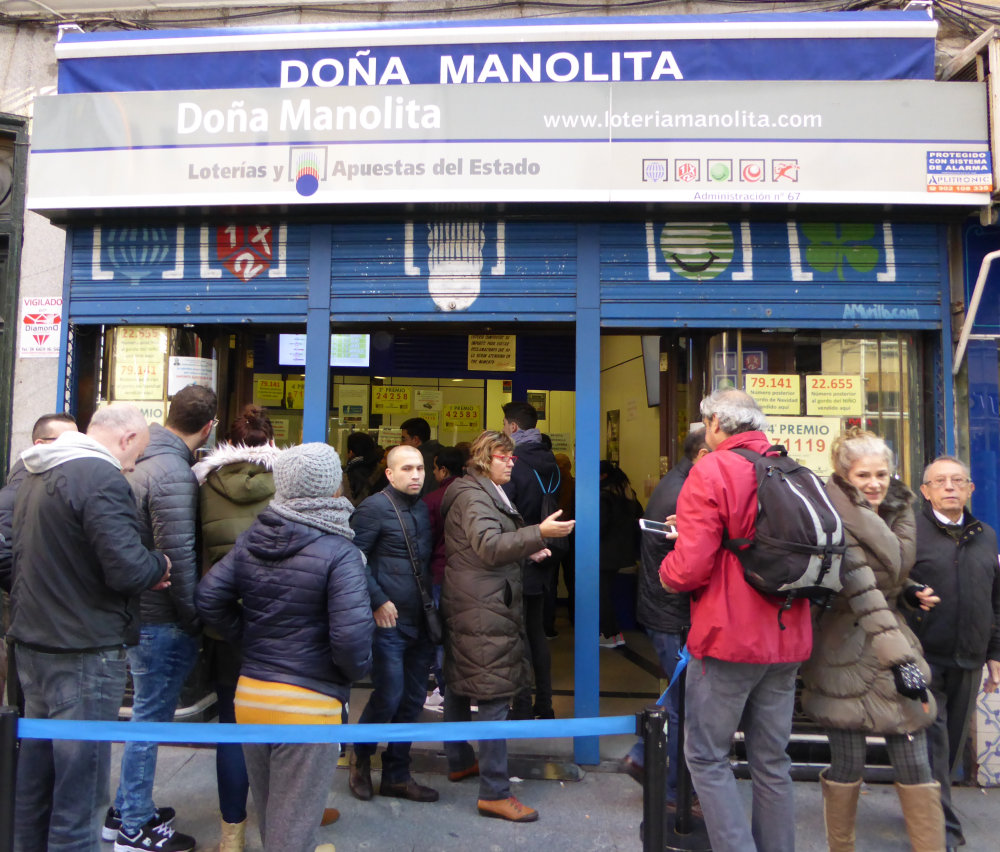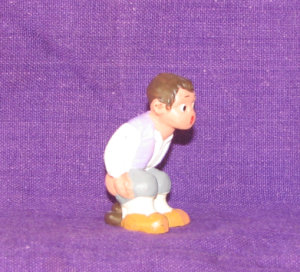The Fat One is coming.
Every year, on the morning of December 22, Spain virtually stops. Childish voices singing out numbers are everywhere: all radios and TV’s are tuned to the same station. Everywhere people are listening, watching, waiting, sometimes with slips of paper on the table by them. Waiting to know if their lives will change that day – or not.
It’s the Gordo, the “Fat One”, Spain’s annual Christmas lottery. And winning the coveted first prize can indeed change lives – 400,000 euros (about $422,000) would be very appreciated in most Spanish households.
The Gordo, some history: The Spanish lottery started in the late 18th century under Carlos III as a less painful way of collecting taxes – part of the money was for prizes and the rest went to the Spanish Treasury. That first lottery was a pick-some-numbers lottery (similar to powerball lotteries and Spain’s current Primitiva). In 1811 Spain was partially under Napoleon, and the Congress of the still-Spanish part of the country (based in southern city of Cádiz) created a new kind of lottery with printed tickets and an assigned number – again to collect tax money. The first Christmas lottery was that system, held on December 18, 1812, with top prize for number 03604.
Those childish voices are the lottery singers from San Ildefonso primary school (located on Plaza de la Paja, one of the prettiest squares in Madrid). With 400 years of history San Ildefonso is one of the city’s oldest schools; until the late 1970’s it was for orphans and mostly boys, with the goal of giving disadvantaged kids a better start in life. (Nowadays some of the students have families and of course there are lots of girls.) Students from this school have been singing out the lottery numbers since 1771, with girls participating since 1984. Children are chosen for their voices, and practice handling the lottery balls all year so the Gordo drawing goes smoothly. In 2016, there are ten boys and ten girls between the ages of nine and thirteen, most of them repeating from 2015.
How the Gordo works: The Christmas lottery is basically the same system as the twice-weekly Lotería Nacional that happens all year, except with much bigger prizes and more numbers in play. Since 2011, numbers range from 00000 to 99999 (Spanish lottery lore says that 00000 always goes to the King but that may be myth). For the Gordo this year, every number has 165 series and every serie has a billete and every billete has ten décimos, so there are 1,650 décimos for every number 0000 – 99999. The serie number and the décimo number are both shown on the ticket as well as the number, so every single ticket sold is different. If you do the math, you can see that means 1,650,000,000 décimos on sale for the 2016 Gordo lottery. Each décimo costs 20 euros, so that’s potentially 33,000,000,000 euros in play.
Who buys and where: Everyone buys, or almost everyone. Most individual people get at least one décimo, some workplaces get entire billetes or even the entire number if the company is big, with employees participating or not – but most do in this situation, probably to avoid that potentially awful situation where everyone wins except the non-players. Families often get a few décimos, and friends frequently exchange halves of décimos with the idea of getting parts of many numbers in hopes that at least a few will win something. It’s also traditional for neighborhood stores, markets or bar-cafés to have several décimos and sell small portions or give them away to favored customers.
Spanish lottery lore claims that specific places are “better” to buy than others. One place is a village in Catalonia called Sort (luck in Catalonian language) where indeed they got a big prize some years ago – busloads of people now go to that village every year to buy lottery. Doña Manolita lottery stand in Madrid is another example – lines are blocks long at Christmas, and street-side lottery sellers claim their tickets are from that same stand. And another bit of lottery lore: lottery falls (or should fall) in disaster areas, so if there have been floods, fires or another catastrophe in the preceding year, people try to buy there thinking that the Universe will somehow even things out by throwing luck to a hard-hit area.
What number to buy? There are several schools of thought for picking a number. One way is to go in with a close idea of what to buy, or at least choosing the last digit, even looking up where to buy an exact number on Internet. Another way is to go to a favorite lottery stand and look at what numbers they have and choose a “pretty” number or at least avoid an “ugly” number, whatever that means to the specific buyer. And the last way is to trust Lady Luck completely, letting lottery seller make the selection. Lottery trivia: statistically, the Gordo has ended in five more often than any other digit, so that’s either an excellent or very bad choice, depending on the buyer’s point of view.
Mechanics of the drawing: There’s a complicated, super-secure system for prior to the Gordo drawing, now done in the Teatro Real Opera House instead of the lottery building. On December 22, there are two big cage-like spheres with wooden balls, all laser cut with numbers, one sphere for the prize numbers and the other for the prizes. The spheres are spun and balls fall down into trays under each sphere and are called out by the children lottery singers in a traditional tune and rhythm. The drawing is entirely random, so the first prize could be the first or the last prize chosen.
Once the lottery drawing is over, the prize list is drawn up rapidly and with the lottery sellers by the afternoon of December 22, as well as in all the newspapers on December 23. Prizes are listed in columns by the last number, and chronologically from the top in each column 0 to 9. Special prizes are listed at the very bottom of the column.
So what are the prizes? The Gordo actually refers to first prize – 400,000 euros for a décimo (20,000 euros per euro played). Second prize is 125,000 euros, third 50,000 euros, two fourth prizes of 20,000 euros and eight fifth prizes of 6,000 euros for a décimo. After the big prizes there are the “almost” prizes (numbers before and after the main prizes) and the “same ending” prizes, where winners get prizes if their number shares one, two or three last digits with the big prizes. And the pedrea, 1,794 random numbers that win 100 euros for a décimo.
All in all, that’s seventeen different kinds of prizes, with a total of 2,310 million euros in prize money, about 70% of the total projected intake for the special lottery (the remaining 30% goes to commission for the lottery sellers and directly to Spanish Treasury). And yes, sometimes tickets go unsold so the intake is less, but sometimes those tickets have prizes that do not need to be paid.
The take-home is the full amount won up to 2,500 euros – after that the State keeps 20% of prize money. That’s relatively new – until 2012 lottery prizes were tax-free. Critics of that newish policy say that the 30% intake going directly to treasury is already plenty of tax withheld, but the decision to add additional tax was made in times of crisis with the government looking for any possible way of increasing revenue.
The last, smallest prize is the reintegro – the get-your-money back prize, where a décimo wins exactly the 20 euros it cost. When that happens, almost everyone “reinvests” in the Niño lottery (January 6) – décimos cost exactly the same and while prizes are lower, there are more prizes so there is a better statistical chance of winning.
But if nothing “falls” in the Gordo or the Niño, there’s always next year….
Lottery trivia: The Gordo is the most famous lottery drawing in a country that dearly loves games of chance. All the lotteries below are state-run:
- Loteria Nacional: similar system as the Gordo and the Niño. Twice a week.
Prizes accumulate on the following if no winner happens at first drawing(s).
- Loteria Primitiva: powerball type lottery, pick six numbers. Twice a week.
- BonoLoto: powerball type lottery, pick six numbers. Six days a week.
- Gordo de la Primitiva: pick five numbers and one in a separate column. Once a week, guaranteed prize of five million euros.
- Euromillon: pick five numbers and two in a separate column. Twice a week, guaranteed prize of fifteen million euros. As name suggests, this is played in most European countries.


